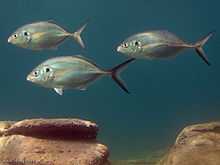| White trevally | |
|---|---|
.jpg) | |
| Scientific classification | |
| Kingdom: | Animalia |
| Phylum: | Chordata |
| Class: | Actinopterygii |
| Order: | Carangiformes |
| Family: | Carangidae |
| Genus: | Pseudocaranx |
| Species: | P. dentex |
| Binomial name | |
| Pseudocaranx dentex (Bloch & J. G. Schneider, 1801) | |
| Synonyms[2] | |
| |
The White trevally (Pseudocaranx dentex), also known as striped jack,[3]) is a jack of the family Carangidae widespread in tropical and warm temperate areas between 40°N and 47°S, in the Atlantic, Mediterranean, Indian and Pacific Oceans. It has a deep body, and a greenish colour with metallic overtones and a dark spot above the gills. The fins are yellow. Trevally are strong fighters and the flesh is good to eat if a little dry. It is often used as cut baits. Maximum size is about 120 cm.
In New Zealand, this trevally is known by the Māori as araara, and is generally confined to waters north of Cook Strait, although it sometimes reaches as far south as Otago in the summer.
Relationship with humans
The IGFA all tackle world record for the species sits at 15.25 kg (33 lb 9oz) caught near Tokyo, Japan in 1998.[4]
References
- ^ Smith-Vaniz, W.F.; Williams, J.T.; Pina Amargos, F.; Curtis, M. & Brown, J. (2015). "Pseudocaranx dentex". IUCN Red List of Threatened Species. 2015: e.T190070A16643997. doi:10.2305/IUCN.UK.2015-4.RLTS.T190070A16643997.en.
- ^ Froese, Rainer and Pauly, Daniel, eds. (2019). "Pseudocaranx dentex" in FishBase. August 2019 version.
- ^ Mori, K.; Nakai, T.; Muroga, K.; Arimoto, M.; Mushiake, K.; Furusawa, I. (1992). "Properties of a new virus belonging to nodaviridae found in larval striped jack (Pseudocaranx dentex) with nervous necrosis". Virology. 187 (1): 368–371. doi:10.1016/0042-6822(92)90329-N. PMID 1736540.
- ^ "Trevally, White". igfa.org. IGFA. Retrieved 14 June 2019.
- Froese, Rainer and Pauly, Daniel, eds. (2006). "Pseudocaranx dentex" in FishBase. March 2006 version.
External links
- Photos of White trevally on Sealife Collection

